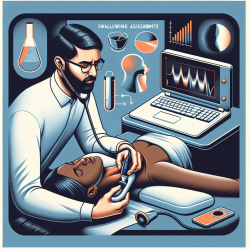As a special education director, I understand the importance of staying abreast of the latest research to provide the best possible care for our students. Today, I want to share some exciting findings from a recent study titled Using Sequence Analyses to Quantitatively Measure Oropharyngeal Swallowing Temporality in Point-of-Care Ultrasound Examinations: A Pilot Study. This research could significantly enhance the skills of practitioners involved in swallowing assessments and therapy.
The study, conducted by Lam et al. (2024), proposes a systemic conceptualization of swallowing physiology and applies sequence analyses to quantify and characterize swallowing temporality. Here are the key takeaways that can help practitioners improve their skills:
- Understanding Swallowing Temporality: The research highlights the importance of well-timed control of oropharyngeal and laryngeal structures to achieve airway protection and swallowing efficiency. Practitioners can use this understanding to better assess and treat swallowing disorders.
- Utilizing Point-of-Care Ultrasound (POCUS): The study demonstrates that POCUS is a non-invasive, task-specific, and relatively accessible modality for swallowing assessments. This is particularly beneficial for working with diverse populations, including those in primary care, outreach, and telepractice settings.
- Applying Sequence Analyses: Sequence analyses, including overlap coefficients, Shannon entropy, and longest common subsequence algorithms, provide a quantitative measure of swallowing temporality. These techniques can help practitioners identify obligatory sequences and variability in swallowing patterns, which are crucial for accurate diagnosis and treatment planning.
- Recognizing Age and Dysphagia Impact: The study found that aging and dysphagia significantly impact the concurrency and variability of swallowing sequences. Practitioners can use these insights to tailor their interventions based on the specific needs of different age groups and individuals with dysphagia.
Implementing these research findings in clinical practice can lead to more accurate assessments and effective interventions, ultimately improving patient outcomes. Additionally, this study lays the groundwork for future AI-assisted dysphagia assessments using POCUS, offering even more precise and efficient diagnostic tools.
To read the original research paper, please follow this link: Using Sequence Analyses to Quantitatively Measure Oropharyngeal Swallowing Temporality in Point-of-Care Ultrasound Examinations: A Pilot Study.
Let's continue to explore and integrate these advancements into our practice, ensuring we provide the highest quality care for our students and patients.










